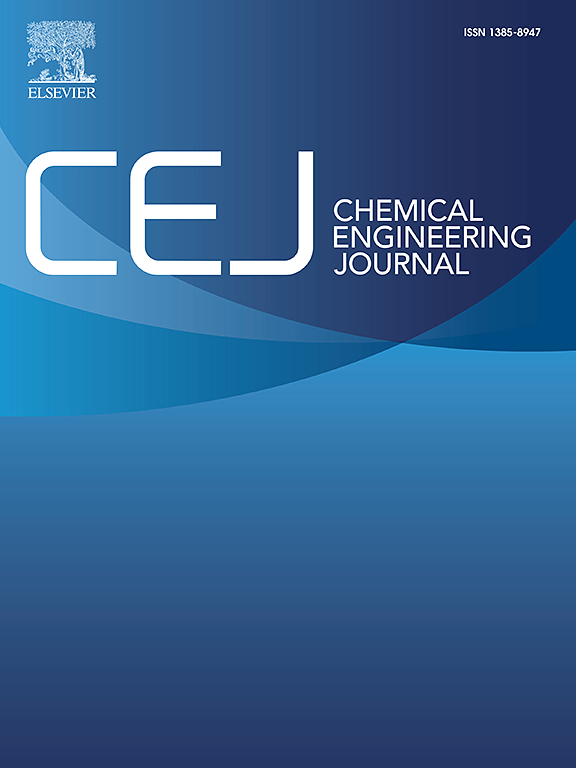Polysaccharide hydrogel-reinforced nanofibrous composite promotes annulus fibrosus regeneration by regulating mitochondrial antioxidant and metabolic functions
IF 13.2
1区 工程技术
Q1 ENGINEERING, CHEMICAL
引用次数: 0
Abstract
Nucleotomy, a surgical procedure employed to address nucleus pulposus (NP) herniation, frequently results in defects within the annulus fibrosus (AF). Owing to the inherently limited self-repair ability of AF tissue, untreated lesions may precipitate reherniation of the NP, thereby accelerating the degeneration of the intervertebral disc. In this study, we introduce a novel composite scaffold comprising hydrogel-reinforced electrospun nanofibers, engineered to mimic the heterogeneous microarchitecture of the native AF matrix while offering improved mechanical support. A mesh-like polycaprolactone (PCL)/gelatin methacryloyl (GelMA) hybrid electrospun nanofibrous membrane was designed to replicate the AF outer region, while a hydrogel mixture of fucoidan methacryloyl (FuMA) and GelMA was sprayed to the membrane surface to emulate the inner region. The integrated FuMA/GelMA hydrogel and PCL/GelMA nanofiber layer enhanced the proliferation of AF cells and markedly improved the synthesis of AF matrix components. Importantly, even under oxidative stress induced by hydrogen peroxide, this hydrogel-reinforced nanofibrous composite effectively maintained the mitochondrial functions of AF cells, thereby supporting their energy metabolism and matrix anabolism. Further molecular experiments unraveled that this composite protected AF cells from oxidative damage through activation of the NRF2-mediated antioxidant enzymes, such as heme oxygenase 1. In a rat caudal disc box defect model, the implantation of a hydrogel-reinforced nanofibrous composite promoted the regeneration of AF tissue, preserved the hydration of NP tissue, and inhibited intervertebral disc degeneration. This approach represents a promising strategy for the repair of nucleotomy-induced AF damage, thereby offering potential therapeutic benefits for patients experiencing intervertebral disc degeneration.

多糖水凝胶增强纳米纤维复合材料通过调节线粒体抗氧化和代谢功能促进纤维环再生
核切开术是一种用于治疗髓核(NP)疝的外科手术,通常会导致纤维环(AF)内的缺陷。由于房颤组织固有的自我修复能力有限,未经治疗的病变可能导致NP再次突出,从而加速椎间盘退变。在这项研究中,我们介绍了一种新型的复合支架,包括水凝胶增强的静电纺丝纳米纤维,旨在模仿天然AF基质的异质微结构,同时提供改进的机械支持。设计了一种网状聚己内酯(PCL)/明胶甲基丙烯酰(GelMA)杂化电纺纳米纤维膜来复制AF的外部区域,而将岩藻聚糖甲基丙烯酰(fua)和GelMA的水凝胶混合物喷射到膜表面来模拟AF的内部区域。复合的fua /GelMA水凝胶和PCL/GelMA纳米纤维层增强了AF细胞的增殖,显著提高了AF基质成分的合成。重要的是,即使在过氧化氢诱导的氧化应激下,这种水凝胶增强的纳米纤维复合材料也能有效地维持AF细胞的线粒体功能,从而支持其能量代谢和基质合成代谢。进一步的分子实验揭示了这种复合物通过激活nrf2介导的抗氧化酶(如血红素加氧酶1)来保护AF细胞免受氧化损伤。在大鼠尾盘盒缺损模型中,水凝胶增强纳米纤维复合材料的植入促进了AF组织的再生,保持了NP组织的水化,抑制了椎间盘退变。这种方法代表了修复核切开术引起的房颤损伤的一种有希望的策略,从而为经历椎间盘退变的患者提供了潜在的治疗益处。
本文章由计算机程序翻译,如有差异,请以英文原文为准。
求助全文
约1分钟内获得全文
求助全文
来源期刊

Chemical Engineering Journal
工程技术-工程:化工
CiteScore
21.70
自引率
9.30%
发文量
6781
审稿时长
2.4 months
期刊介绍:
The Chemical Engineering Journal is an international research journal that invites contributions of original and novel fundamental research. It aims to provide an international platform for presenting original fundamental research, interpretative reviews, and discussions on new developments in chemical engineering. The journal welcomes papers that describe novel theory and its practical application, as well as those that demonstrate the transfer of techniques from other disciplines. It also welcomes reports on carefully conducted experimental work that is soundly interpreted. The main focus of the journal is on original and rigorous research results that have broad significance. The Catalysis section within the Chemical Engineering Journal focuses specifically on Experimental and Theoretical studies in the fields of heterogeneous catalysis, molecular catalysis, and biocatalysis. These studies have industrial impact on various sectors such as chemicals, energy, materials, foods, healthcare, and environmental protection.
 求助内容:
求助内容: 应助结果提醒方式:
应助结果提醒方式:


